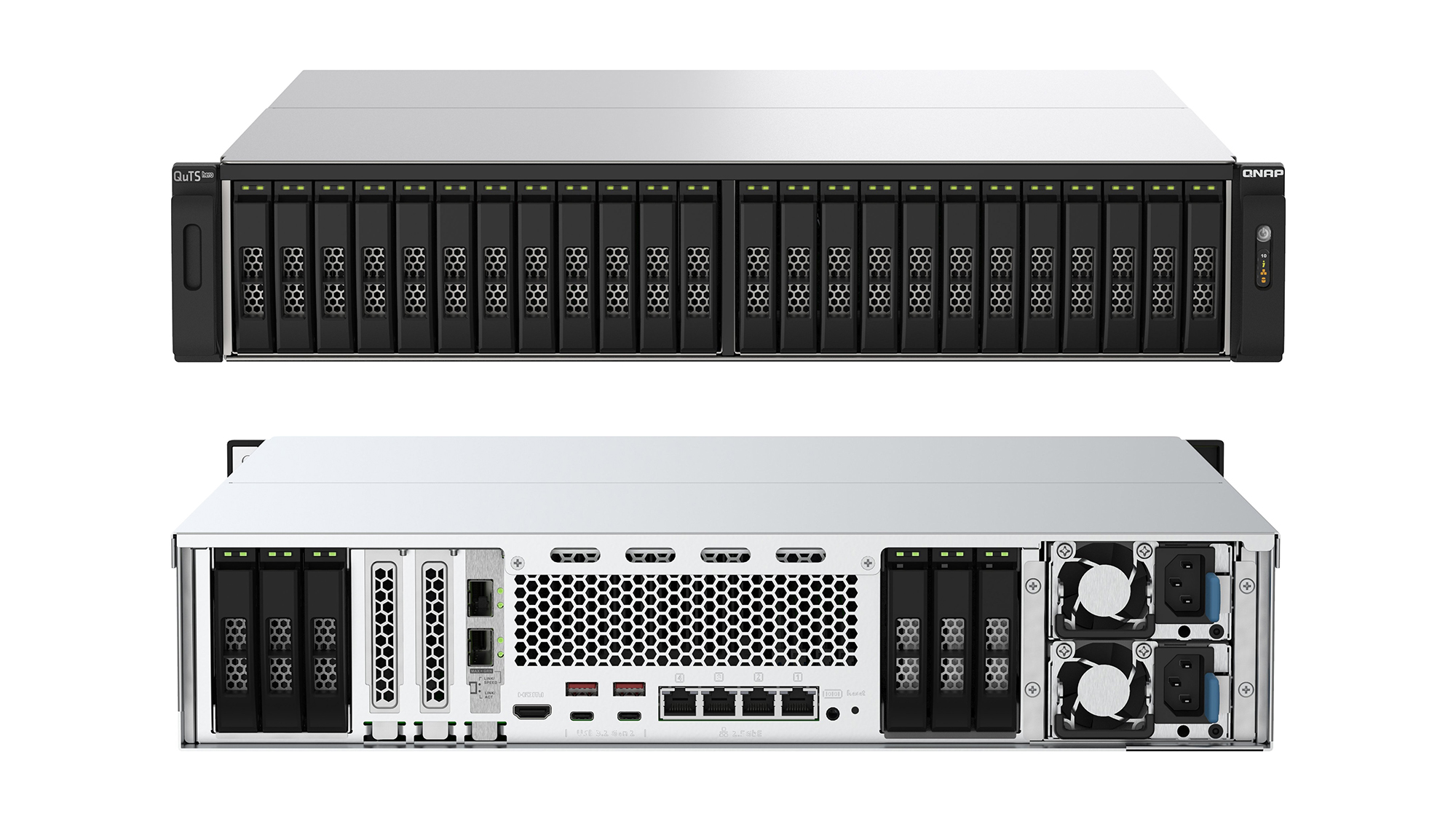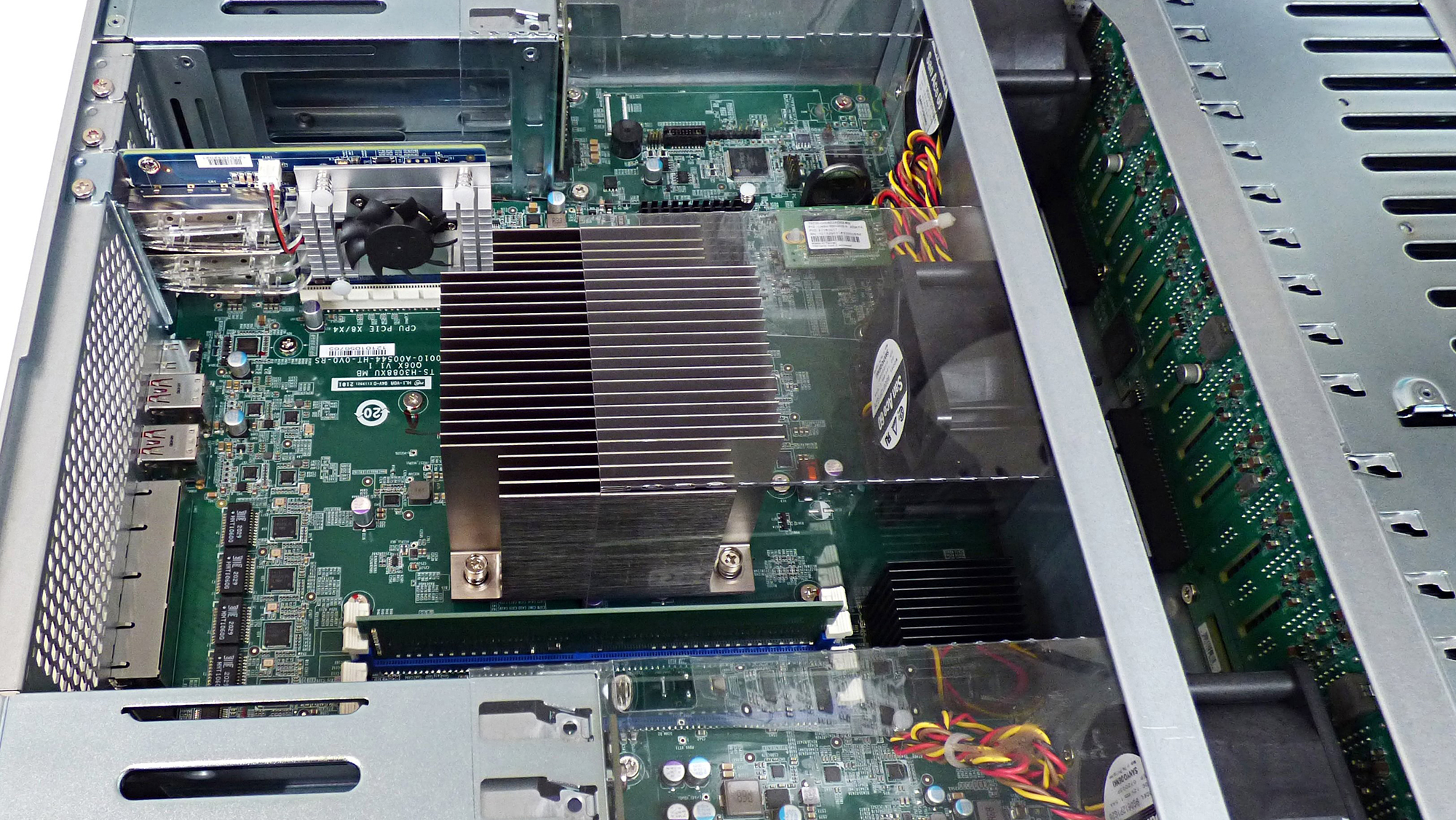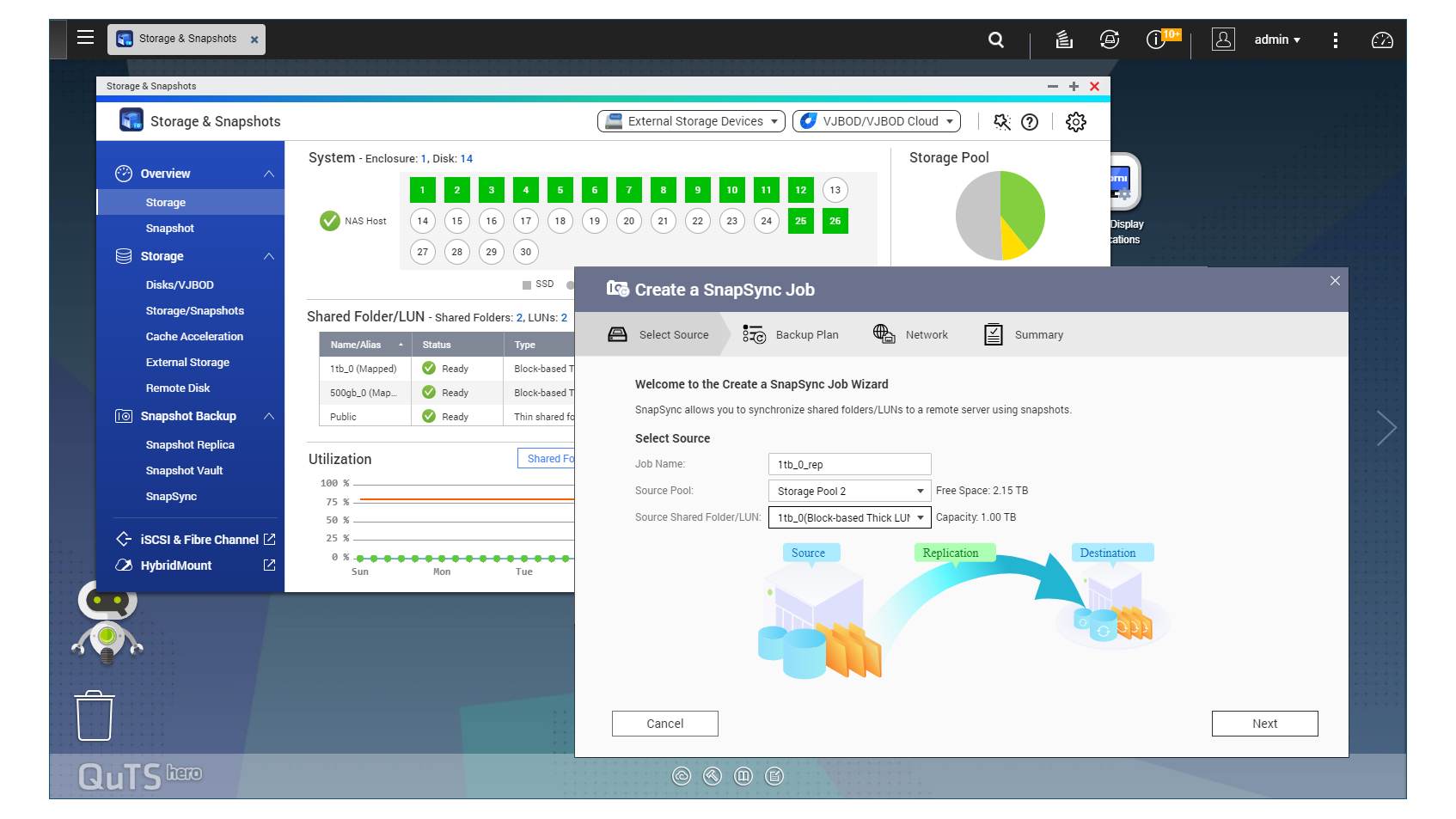Qnap TS-h3088XU-RP review: Super-dense SSDs at a great price
An affordable AFA with great 25GbE performance and more SSD bays than anyone else


-
+
Very high SSD density
-
+
Great value
-
+
25GbE card included
-
+
Good NAS and IP SAN performance
-
+
Choice of QTS and QuTS hero OSes
-
-
Only HDMI 1.4b port

SMBs that want an affordable all-Flash array (AFA) will find Qnap’s TS-h3088XU-RP could be just what they’re looking for. While SAS and NVMe SSD AFAs deliver in the performance stakes, they’re painfully expensive to populate but this rack appliance keeps your outlay at a more manageable level by supporting lower-cost SATA SSDs.
What’s more, the TS-h3088XU-RP has room for up to 30 SSDs, making it one of the highest capacity 2U AFAs on the market. It has plenty of power on tap, too; the model on review sports a 3.3GHz six-core Xeon W-1250 CPU, partnered by 32GB of DDR4 memory.
Those that want even more performance can opt for a higher-spec version driven by a 3.4GHz eight-core Xeon W-1270. This also doubles base memory to 64GB, and both models support up to 128GB using four standard 32GB DIMMs.
Qnap TS-h3088XU-RP review: Hardware features
The appliance achieves this impressive storage density by presenting 24 standard SSF bays at the front and employing two triple-drive cages at the rear. They’re all hot-swappable, support SATA HDDs as well as SSDs and are all connected to the same centrally mounted drive backplane.
The TS-h3088XU-RP is ready for some serious network action as along with four embedded 2.5GbE multi-Gig ports, the price includes a Qnap dual-port 25GbE SFP28 PCI-E card. Further expansion is possible via two free PCI-E slots - but be careful what you put in them as using the second X4 slot will drop the primary slot with the 25GbE card from x8 down to x4 speeds.

Qnap has also aimed this appliance at media editors; the Xeon W CPUs have an integrated Intel UHD Graphics P630 GPU, which supports real-time video transcoding and feeds 30Hz 4K video through to the rear HDMI port, although this is the 1.4b variety and not the higher-bandwidth 2.0 version.
Power redundancy is handled by a pair of 550W hot-plug PSUs with three internal cold-swap fans managing all cooling. Air shrouds on each one push air through the rear SFF cages and over the CPU and we measured acceptable sound levels of 63dB from one metre in front.
Sign up today and you will receive a free copy of our Future Focus 2025 report - the leading guidance on AI, cybersecurity and other IT challenges as per 700+ senior executives
Qnap TS-h3088XU-RP review: QTS vs QuTS hero
The TS-h3088XU-RP supports Qnap’s QTS and QuTS hero OSes, and you can choose which one to install from the QFinder deployment app. Most businesses will undoubtedly go for the latter as it offers superior enterprise-class data protection features including ZFS copy-on-write for fast, near unlimited snapshots plus inline data deduplication and compression.
Self-healing of data corruption is handled by end-to-end checksums while replication to remote appliances gets a speed boost as it only sends changed blocks. Along with the usual RAID suspects, you can choose from triple parity RAID to protect against three drive failures or triple mirroring which stores identical copies of data on three drives.
NAS share data can be protected with one of two WORM (write once read many) policies. The Enterprise policy allows a protected folder to be deleted but stops anything in it from being individually modified or removed while the stronger Compliance policy blocks folder deletion and only allows it to be removed by deleting the entire storage pool.
Qnap TS-h3088XU-RP review: QuTS hero apps

Whichever OS you choose, you’ll find both easy to use as they offer almost identical web browser interfaces. There’s little between them for apps either, and we counted no less than 111 available for QuTS hero. The standard iSCSI & Fibre Channel app is used to create IP SANs and you can apply thick or thin provisioning, deduplication and compression.
Manual and scheduled snapshots for NAS volumes and iSCSI LUNs are run from the Storage & Snapshots app and can be scheduled as often as every 5 minutes. The SnapSync feature supports NAS shares and iSCSI LUNs and replicates data to remote QuTS appliances using block-level replication run to a schedule or in real time.
QuTS hero also provides plenty of backup apps such as Hybrid Backup Sync (HBS) 3 and Hyper Data Protector for protecting VMware and Hyper-V virtualized environments. Virtualization is on the menu too, with the Container Station, Ubuntu Linux Station and Virtualization Station apps all present.
The HybridDesk Station app brings the HDMI port into play. With an HD TV, keyboard and mouse connected, we used its desktop interface to access the various plug-ins which included direct access to Chrome, Firefox, Skype and Facebook while the HybridDesk Station allows the appliance to be managed locally.
Qnap TS-h3088XU-RP review: 25GbE performance
For performance testing, we installed two 1.92TB Micron 5200 SATA SSDs in the rear carriers to use as a mirrored QuTS system pool and loaded twelve 500GB Western Digital Red SA500 SSDs in the front bays and created a RAID6 array for general data storage.

Starting with IP SANs, we created a 1TB iSCSI target and mapped it over a dual 25GbE MPIO connection to a Dell EMC PowerEdge T640 Xeon Scalable server running Windows Server 2019. Performance is impressive with Iometer recording raw sequential read and write rates of 35.5Gbits/sec and 32.6Gbits/sec with random operations returning 34.6Gbits/sec and 30.1Gbits/sec.
I/O throughput is up there too, as 4KB Iometer block sizes delivered sequential read and write rates of 246,500 and 226,005 IOPS. Swapping to random operations saw equally good read and write throughputs of 242,700 and 147,000 IOPS.
NAS performance is nothing to sniff at either, with a share mapped to the server over a single 25GbE connection delivering sequential read and write rates of 23.1Gbits/sec and 22.6Gbits/sec and random rates of 23.1Gbits/sec and 20.3Gbits/sec. The share also returned sequential and random read and write throughputs of 128,400 and 121,900 IOPS and 128,010 and 79,000 IOPS.
Qnap TS-h3088XU-RP review: Verdict
With prices for a diskless unit starting at less than £4,200, the TS-h3088XU-RP offers a very affordable alternative to costly SAS/NVMe AFAs and it won’t be beaten for sheer SSD density. Qnap’s QuTS hero OS offers great enterprise-class data protection features and the inclusion of a 25GbE adapter card adds extra value while NAS and IP SAN performance over 25GbE is very good.
Qnap TS-h3088XU-RP specifications
| Chassis | 2U rack chassis |
| CPU | 3.3GHz six-core Xeon W-1250 |
| Memory | 32GB ECC DDR4 UDIMM (max 128GB) |
| Storage | 30 x SATA SFF hot-swap bays |
| RAID | RAID0, 1, 5, 6, 10, 50, 60, Triple Parity, Triple Mirror (with QuTS) |
| Expansion | 1 x PCI-E Gen 3 x8, 2 x PCI-E Gen 3 x4 slots |
| Network | 4 x 2.5GbE, 2 x 25GbE SFP28 card |
| Other ports | 2 x Type-C USB 3.2, 2 x Type-A USB 3.2, HDMI 1.4b |
| Power | 2 x hot-plug 550W PSUs |
| Management | Web browser |
| Warranty | 3 year limited |
Dave is an IT consultant and freelance journalist specialising in hands-on reviews of computer networking products covering all market sectors from small businesses to enterprises. Founder of Binary Testing Ltd – the UK’s premier independent network testing laboratory - Dave has over 45 years of experience in the IT industry.
Dave has produced many thousands of in-depth business networking product reviews from his lab which have been reproduced globally. Writing for ITPro and its sister title, PC Pro, he covers all areas of business IT infrastructure, including servers, storage, network security, data protection, cloud, infrastructure and services.
-
 Gender diversity improvements could be the key to tackling the UK's AI skills shortage
Gender diversity improvements could be the key to tackling the UK's AI skills shortageNews Encouraging more women to pursue tech careers could plug huge gaps in the AI workforce
By Ross Kelly Published
-
 Researchers claim Salt Typhoon masterminds learned their trade at Cisco Network Academy
Researchers claim Salt Typhoon masterminds learned their trade at Cisco Network AcademyNews The Salt Typhoon hacker group has targeted telecoms operators and US National Guard networks in recent years
By Emma Woollacott Published
-
 HPE says unified channel strategy won't force Juniper partners to generalize
HPE says unified channel strategy won't force Juniper partners to generalizeNews Does the company embrace specialists or want a full portfolio push? The answer, it seems, is both
By Jane McCallion Published
